- Equity markets quite quickly found a bottom around late March, shortly after China reported no locally spread infections for the first time since the Wuhan outbreak. For investors in Asia, this was an important signal that the disease spread could be suppressed.
- The shift online of both corporate and consumption activities saw hardware and software technology rise to the occasion, accelerating trends that were already in motion pre crisis. The strength of China’s online ecosystem, which is heavily represented in the China Index, helped support a return to positive economic growth in Q2 as production started to return after the spread of Covid-19 was brought under control. As such, for the full year China is likely to grow 2% in 2020, outperforming developed nations by a wide margin.
- The Trump administration’s continued adversarial approach towards China, including exerting pressure on US allies to stop using Huawei 5G equipment, and measures aimed at restricting supply chains of high-end semiconductor chips and equipment to Chinese companies, forced China to embark on a push towards supply chain self-reliance, particularly in high-tech components.
- Joe Biden’s presidency should see the return of professional US diplomacy, with the effort to “heal America” spilling over to the rest of the world, including in US-China relations and China-Australia relations, though some damage may remain.
If I were to sum up Asia ex Japan equity markets in 2020, it would be the pain of negative headwinds followed by the triumph of human ingenuity and determination in rising above them. This perhaps seems too optimistic a story for such a year, given how the world has suffered from Covid-19, but not too far-fetched if the performance of equity markets can be submitted as a verdict.
Pandemic pain
Equity markets quite quickly found a bottom around late March, shortly
after China reported no locally spread infections for the first time since
the Wuhan outbreak. For investors in Asia this was an important signal
that the disease spread could be suppressed. The pandemic’s impact in
the US brought forth strong monetary stimulus, which facilitated central
banks in Asia to do likewise without fear of severe currency weakening.
This sparked fresh optimism.
The prospect of a post-pandemic recovery should see very strong economic performances across the world, with Asia’s growth again anchored by China
The shift online of both corporate and consumption activities saw
hardware and software technology rise to the occasion, accelerating
trends that were already in motion pre crisis. As a result, the information
technology sub-index grossly outperformed (see Figure 1), resulting in
the strong performances of the Taiwan and Korea equity indices.
Figure 1: Long-term global IG corporate spreads

Source: Bloomberg, December 2020.
The strength of China’s online ecosystem, which is heavily represented
in the China Index, helped support a return to positive economic growth in
Q2 as production started to return after the spread of Covid-19 was brought
under control. As such, for the full year China is likely to grow 2% in 2020,
outperforming developed nations by a wide margin.
Not all Asia economies fared as well, however. Those countries more
heavily reliant on tourism, such as Thailand, suffered badly. India,
Indonesia and the Philippines also had difficulty keeping infections in
check, while lacking the benefit of a more buoyant online ecosystem to
facilitate continuing commercial activities where people movement had
to be curtailed.
Political hostilities
The Trump administration continued its adversarial approach towards
China, including exerting pressure on US allies to stop using Huawei 5G
equipment, and measures aimed at restricting supply chains of high-end
semiconductor chips and equipment to Chinese companies. This forced
China to embark on a push towards supply chain self-reliance, particularly
in high-tech components.
This forms part of China’s broader “dual circulation” strategy targeted at
increasing the reliance on its own demand for sustaining economic growth.
Other aspects include the promotion of domestic travel and strengthening
the quality of local brands to compete with premium foreign goods.
Notably, it does not mean moving away from China integrating itself into
the global trading network, with the China-led Regional Comprehensive
Economic Partnership (RCEP) successfully signed in November with
the 10 South-east Asian countries, South Korea, Japan, Australia and
New Zealand. China is also considering joining the Comprehensive and
Progressive Agreement for Trans-Pacific Partnership (CPTPP), which
replaced the Trans-Pacific Partnership (TPP) following US withdrawal
under Trump’s “America first” pivot.
Climate change
China’s climate change efforts also forged ahead during the year, with
stocks linked to electric vehicles (EVs) and solar energy capping a stellar
year for equities. These stocks should continue to do well in 2021 under
President-elect Joe Biden as he seeks to turn the US back towards the
climate change agenda in the next four years.
2021: potentially more win-win outcomes
In geopolitical terms, Biden’s presidency should see the return of
professional US diplomacy, with the effort to “heal America” spilling over
to the rest of the world, including in US-China relations and China-Australia
relations, though some damage may remain.
China’s climate change efforts forged ahead during the year, with stocks linked to electric vehicles and solar energy capping a stellar year for equities
The prospect of a post-pandemic recovery should see very strong
economic performances across the world, with Asia’s growth again
anchored by China where the street and the World Bank is expecting
around 8% real GDP growth.1 Against this backdrop, 2021 should be
another strong year for equities, whereby sectoral performances are less
bifurcated. Non-tech sectors should rebound strongly, but tech stocks
will also perform as themes such as 5G, artificial intelligence, big data,
EVs, cloud computing, ecommerce and video live-streaming still have
lots of momentum.





